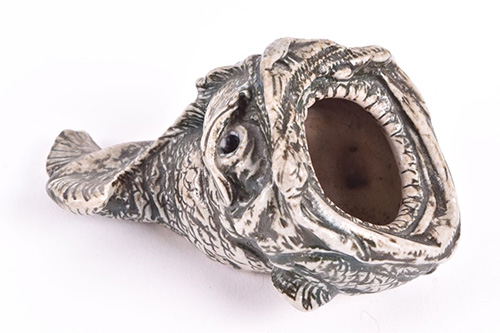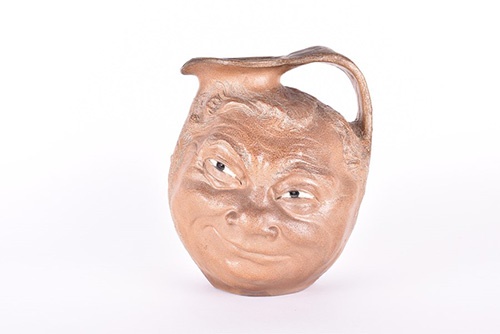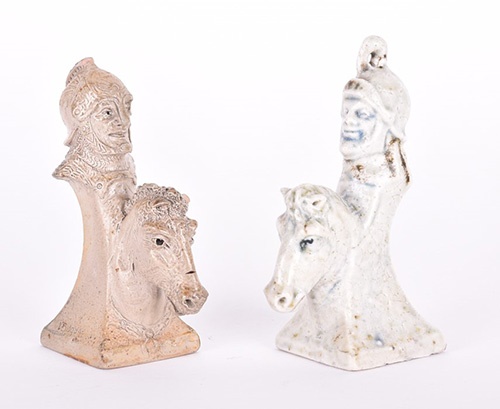The History of Martin Brothers Pottery
Family feuds and one of the most influential decorative art movements of the twentieth century
07/09/2022
Eccentric, whimsical and grotesque: the Martin Brothers’ distinctive aesthetic reflects the changing styles of the period and the egotistical minds of the four brothers responsible for them.
Robert Wallace Martin, born in 1843, was the eldest brother and the one who began the enterprise. Inspired at an early age, Wallace grew up in the immediate presence of some of the most extraordinary examples of gothic architecture in the world such as Westminster Abbey and the Houses of Parliament. As a result, the gothic style was ingrained into Wallace. He became so captivated by the construction going on around him, that he would find lumps of chalk from around the site and carve things out of them. This was hugely encouraged by his father, and before too long he was sketching gothic designs alongside his sculptures.
Fast forward some fifteen or so years, after training at the Lambeth School of Art, and his three younger brothers following in his footsteps and practicing in his studio in Fulham, the family upsized and moved their studio to Havelock Road, Southall in 1877. It was here, in their studio on the canal, that they created some of their finest and most recognised pieces of work to date.
 A Martin Brothers spoonwarmer modelled as a grotesque fish
A Martin Brothers spoonwarmer modelled as a grotesque fish
The vogue of the 1860s had been the Gothic Revival, however, the 1870s and 80s saw an influx of Japanese styles influencing the decorative arts, along with a Renaissance Revival that adopted flora and fauna patterns, mirroring those of the French Renaissance.
The Martin Brothers, with their own unique style, showed that they were not at all shy in embracing these changes. Their designs had a profound impact on the decorative arts at that time and played a key role in moving artists away from the dulling historicism motif, and towards a new ‘back to nature’ movement. The product of this movement was Art Nouveau, which typically makes full use of these naturalistic and Japanese influences.
A late 19th century Martin Brothers large vase, by Edwin and Walter Martin
However, as these decades of great artistic reform ended, the air between the brothers began to sour. The early 1890s marked the beginning of the deterioration of their relationship, most likely caused by a serious reduction in demand. The aesthetic movement had burned out after the trials of Oscar Wilde resulted in his societal exile, subsequently curbing a lot of enthusiasm towards the decorative arts. This coupled with the failing of the British economy meant that people were generally less interested in buying decadent homeware.
By the end of the decade, the Martin Brothers were mostly confined to making beer-jars and ginger-beer bottles to keep in with the demands of the time, all the while falling out over Wallace’s autonomy over the enterprise. All the squabbling over the business nearly put an end to it for good.
 A Martin Brothers double-sided very large stoneware face jug
A Martin Brothers double-sided very large stoneware face jug
Luckily, this was not to be the end. The Martin Brothers revival came at the turn of the century. Thanks to the youngest brother, Edwin Bruce Martin, an entirely new artistic outlook was established. Edwin held the least amount of autonomy over the enterprise, but the widest breadth of knowledge. He was often given the unromantic jobs with little significance but the variation of jobs he was responsible for gave him a lot of experience working across the board in the manufacturing process.
To achieve the best results on the large pots, the spaces between them in the kiln needed to be filled, and Edwin’s job was to create small pots to fill these spaces – a job thought by his brothers to be entirely practical with little commercial value. However, his designs proved extremely popular, particularly with architect, Sydney Greenslade, who began writing to Edwin and sending him new and unique designs to play with.
A Martin Brothers stoneware gourd vase by Edwin and Walter Martin
With Edwin’s pots in high demand, the family were back in business and Wallace resumed making his famous wally birds and face-jugs. The birds were born out of experimentation with the owl shaped jars, a very traditional piece of English pottery. Before long, the wally birds had become extremely popular in their own right, and considered to be a very rare today and a distinct piece of Martinware.
An early 20th century Martin Brothers triple bird group by Robert Wallace Martin
Another of Wallace’s popular designs in the business’ rebirth, was the large chess sets, with hand-carved figures like the pair of Knights we sold in September of 2019 for £5,500. The sets were made on an individual basis, with only a handful produced for wealthy people such as stockbroker, Victor Hodgson, for whom the first set was made.
Despite these hugely positive results for Martin Brothers Pottery in the early 20th century, nothing could mend the worsening relationship between the brothers. Moreover, setbacks such as the fire in their shop on Brownlow Street in 1903, along with various illnesses and deaths in the family, only greatened the rift.
An early 20th century Martin Brothers stoneware chess piece modelled as a knight
Charles Douglas Martin, who ran the shop and held the position of Aesthetic Director, lost the role and was quietly held responsible for the fire, upsetting him deeply. Whilst Edwin and Walter Fraser Martin grew increasingly frustrated with Wallace’s attitude and domineering leadership, and threatening on numerous occasions to go abroad and restart.
Although the jealousy and rivalry that plagued the brothers was never resolved, the enterprise still managed to run strong up until the death of the eldest and last remaining brother, Wallace. Despite the ups and downs, it was held together by four brothers who may not have had much love for each other, but a deep love for pottery.
Related Articles
What does the term studio pottery mean?
Martin Brothers sale highlights
Large collection of Martin Ware for sale in September
The rise and rise of studio pottery
Have you got any Martin Brothers pottery you're thinking of selling?
Our team of experts at Dawsons are always happy to provide a free verbal appraisal and auction valuation; regularly consigning many wonderful items to our monthly Fine Art, Antiques & Asian Art sale.
We can also provide insurance valuations, where required.
We would love to hear from you
0207 431 9445 / info@DawsonsAuctions.co.uk


